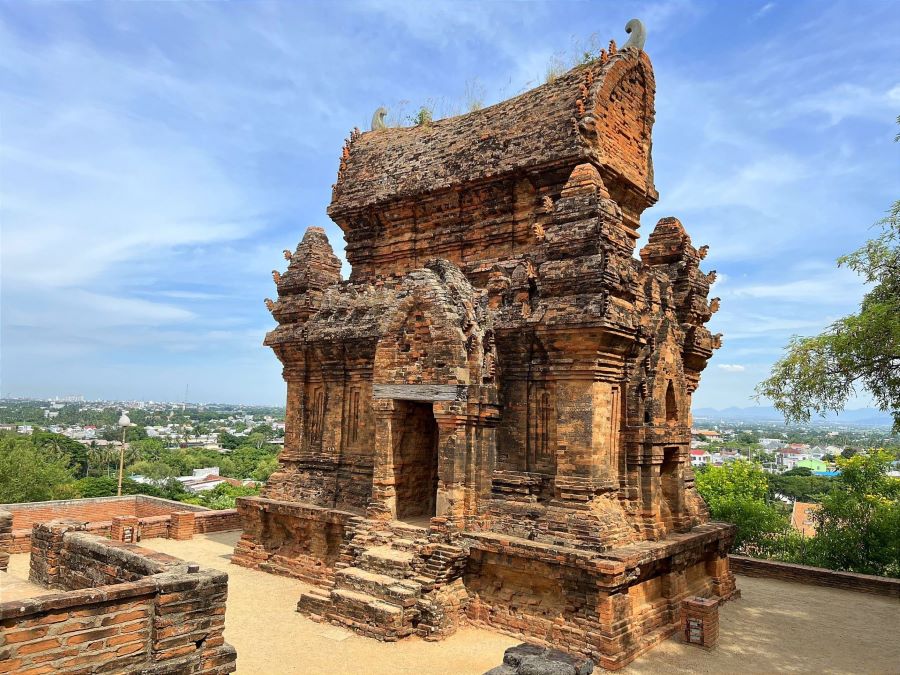Best Terraced Rice Fields in Northern Vietnam – Scenic Travel Guide
Terraced Rice Fields in Northern Vietnam – often hailed as the “Stairway to Heaven” – are breathtaking masterpieces created by the hardworking ethnic communities of the highlands. Vietnam is renowned for having some of the most stunning fields in the world, making it a must-see for any Vietnam Travel journey. In this article, we will take you on a journey to explore these awe-inspiring landscapes and discover the unique charm that awaits when you Travel to Northern Vietnam.
The Most Breathtaking Terraced Rice Fields in Vietnam – The Ultimate List You Can’t Miss
Sa Pa Terraced Rice Fields (Lao Cai)
Location & Geography
Sapa sits high in Lao Cai province, tucked deep in the far north of Vietnam. Surrounded by the towering peaks of the Hoang Lien Son range, it offers sweeping views of hills and valleys layered with rice terraces. The charm doesn’t stop at Sapa town-nearby districts like Bac Ha, Bat Xat, and Si Ma Cai are also home to equally breathtaking scenery. Joining Sapa tours is a great way to reach these places, following winding mountain roads that pass through mist-covered forests and small, welcoming villages along the way.

Clouds drift gently above Sapa’s terraced rice fields, mirroring the valleys below.
Climate
The region enjoys a subtropical highland climate, making it pleasantly cool and fresh compared to the lowlands. May and June are particularly special, marking the “water pouring season” when the rains arrive. This is the moment when the terraces fill with shimmering water, turning into giant mirrors that reflect the sky. It is also the beginning of the rice planting season, when fields come alive with the activity of local farmers preparing their crops.
What makes this area truly unforgettable is the deep connection between the land and the people. For centuries, ethnic groups such as the Dao and Hmong have shaped
Unique Features
For centuries, ethnic groups like the Dao and Hmong have carved the hills into productive farmland.
The Terraced rice fields are both a masterpiece of agricultural design and a practical way to farm on steep slopes.
These landscapes preserve cultural heritage while attracting travelers from around the world.
Mu Cang Chai Terraced Rice Fields – A Hidden Gem in Yen Bai
Location & Geography
Mu Cang Chai, in Yen Bai province, lies about 300 km from Hanoi. It is famous as one of the most stunning places to capture the golden rice harvest, attracting photographers and travelers from all over the world. The area boasts the largest terraced rice field system in Vietnam and the second largest in the world, after the Banaue terraces in the Philippines. Terraces cover the hills in every direction, with the land shaped by high mountains, deep valleys, and winding streams. Pine forests, steep slopes, and the famous round “Mam Xoi Hill” create landscapes that are both grand and photogenic.
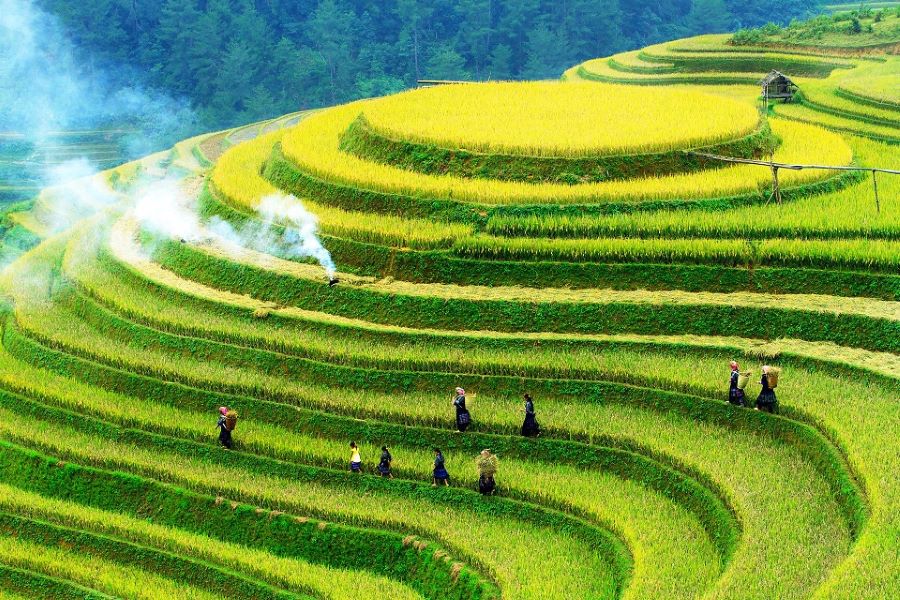
Mist rises gently over Mu Cang Chai’s terraced rice fields at dawn.
Climate
May to June marks the “water pouring season,” when the terraces fill with water and take on a calm, earthy beauty. This is the quiet charm of the northwest highlands-subtle colors, soft reflections, and peaceful rural life. September and October bring the peak season, when the fields turn golden and shine under the autumn sun. This is when visitors flock here to see the famous “golden stairs” stretching up the mountainsides.
Unique Features
- Mam Xoi Hill – Famous for its terraces shaped into perfect circular patterns that glow under the sunlight, making it a symbol of the Mu Cang Chai terraced field landscape.
- Che Cu Nha – A destination for adventure lovers, offering steep, winding roads and rewarding views of vast golden fields during harvest season.
- De Xu Phinh – Home to 600 hectares of terraces at an elevation of 1,200–1,300 meters, where soft, winding curves contrast beautifully with rugged mountain backdrops.
- Cao Pha Valley – A lush green area with more than 300 hectares of terraces, surrounded by crisp mountain air and peaceful scenery.
- Scenic drive to Cao Pha – Pass endless rice fields, small stilt houses, and quiet villages along the road, perfect for travelers who want to slow down and soak in the beauty of the Mu Cang Chai terraced field region.
Hoang Su Phi Terraced Rice Fields – A Jewel of the Northwest
Location & Geography
Located in Hoang Su Phi district of Ha Giang province, this breathtaking region sits at the foot of the majestic Tay Con Linh peak. It is part of one of the most scenic routes for any Ha Giang tour, where dramatic mountains rise against the horizon and terraced fields stretch endlessly across the slopes. Midway up the mountains, golden terraces line the road, blending seamlessly with the untamed beauty of the northwest highlands.
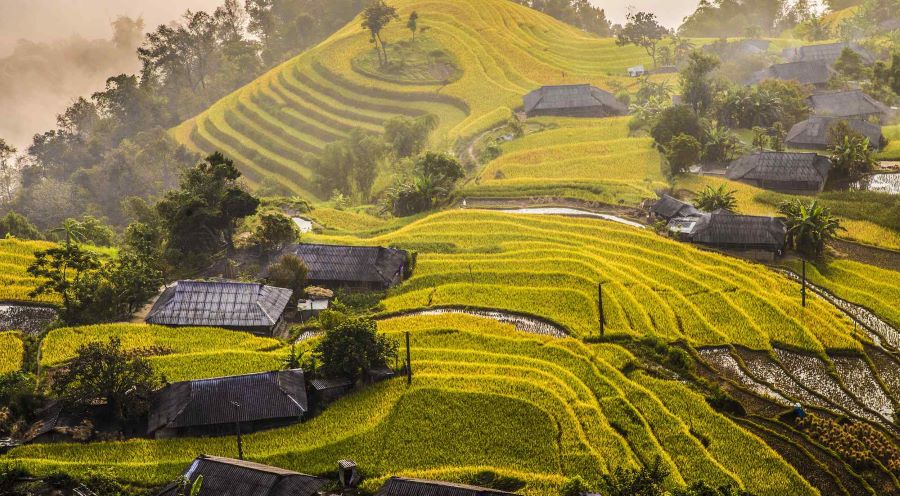
Terraced rice fields in Hoang Su Phi shimmer under morning light and mountain mist.
Climate & Seasons
From May to June, the “water pouring season” turns the terraces into vast mirrors reflecting the bright sky. Mountain streams flow gently down each step, creating a serene scene of water cascading through the valleys. September to October marks the peak season, when the fields transform into golden waves swaying in the breeze-a perfect time to experience the harvest and the warm energy of the highland communities.
Unique Features
- The Hoang Su Phi terraced fields are built on steep slopes, creating bold and dramatic layers that stand out against the rugged mountains.
- Villages along the route offer authentic glimpses into the daily life of the Dao and Nung ethnic communities.
- A visit here blends spectacular landscapes, cultural immersion, and the opportunity to enjoy unique local specialties.
Y Ty Terraced Rice Fields – Misty Beauty in Lao Cai
Location & Geography
Y Ty is a highland commune in Bat Xat district, Lao Cai province, sitting at an altitude of around 2,000 meters above sea level. It is best known for its endless “sea of clouds,” but few travelers realize it is also home to a spectacular “sea of golden rice” each autumn. Surrounded by rugged mountains and lush valleys, the terraces here wind gracefully along the hillsides, offering breathtaking views in every direction.
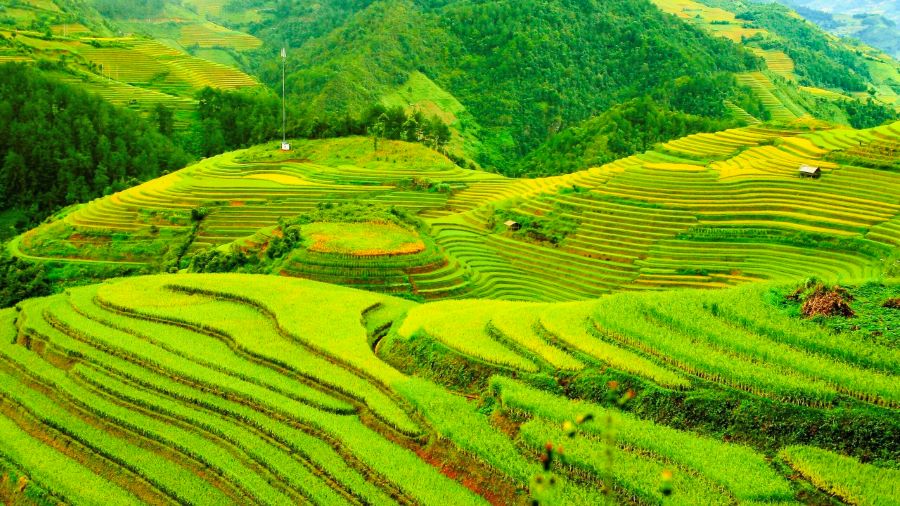
Mist wraps Y Ty terraced rice fields, painting a dreamlike scene across emerald hills.
Climate & Seasons
From May to June, the “water pouring season” arrives with the first summer rains. Water fills the stepped paddies, creating shimmering layers that reflect the sky. This is when local farmers begin plowing and planting for a new crop, turning the fields into a lively scene of community activity. By September and October, the hills transform into golden waves of ripe rice swaying in the breeze, making it one of the most beautiful harvest landscapes in the northwest.
Unique Features
- The Y Ty terraced fields are the result of generations of hard work by the highland ethnic communities of Bat Xat.
- This traditional farming method adapts perfectly to the steep mountain terrain while preserving cultural heritage.
- During planting season, villagers work together in a spirit of solidarity, keeping alive the age-old practice of labor exchange.
- Visiting Y Ty offers a rare opportunity to enjoy both its dramatic landscapes and the close-knit life of its people.
Pu Luong terraced fields (Thanh Hoa)
Location & Geography
Pu Luong is located in Ba Thuoc district, Thanh Hoa province, about 190 km from Hanoi, with a travel time of roughly 3–4 hours. This emerging eco-tourism and retreat destination is becoming increasingly popular among travelers who love nature and off-the-beaten-path adventures. For those seeking both cultural immersion and breathtaking landscapes, a Mai Chau – Pu Luong 3 days 2 nights journey is the perfect choice, combining the charm of Mai Chau’s stilt-house villages with the fresh mountain air of Pu Luong. In the Thai language, “Pu Luong” means “the highest peak,” and the area spans over 17,600 hectares with a rich tropical rainforest ecosystem.
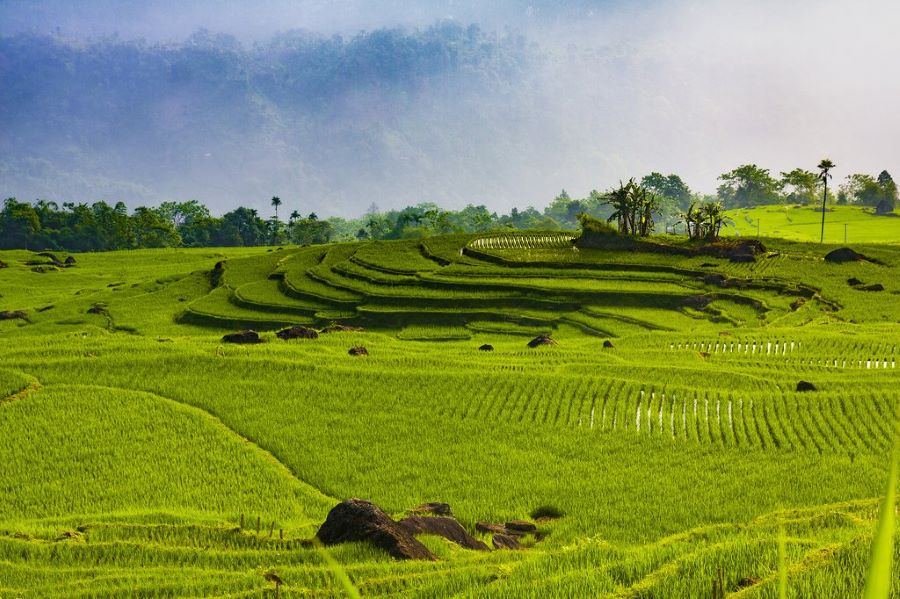
Terraced rice fields in Pu Luong shimmer under golden light and cool mountain air.
Climate & Best Seasons
From late May to early June, Pu Luong turns a fresh shade of green as the new rice crop begins. Despite being summer, temperatures here usually remain below 30°C, offering a cool, refreshing escape with lush greenery all around. September to October marks the golden season, when the terraced fields glow with ripe rice, filling the air with a soothing aroma that perfectly matches the peaceful and familiar charm of the countryside.
Unique Features
- Showcases the unspoiled beauty of the Northwest mountains.
- Features terraced rice fields cascading down the hillsides.
- Home to quiet ethnic Thai and Muong villages.
- Surrounded by dense tropical forests rich in biodiversity.
- Offers opportunities to enjoy authentic local cuisine.
- Encourages visitors to immerse themselves in the daily life of highland communities.
Hong Thai Terraced Fields (Na Hang, Tuyen Quang)
Location & Geography
Hong Thai is blessed with cool, fresh air, majestic mountains, and terraced rice fields gracefully curving along the hillsides. The area is easily accessible from Na Hang, Tuyen Quang-just over an hour’s drive—making it a perfect destination for travelers seeking natural beauty and cultural immersion. The terraces cover a total area of 82 hectares, mainly in Khau Trang, Pac Khoang, and Na Mu villages, stretching along the inter-village roads and the center of Hong Thai commune. Some terraces cling to mid-mountain slopes, while others descend from peaks down to the valleys.
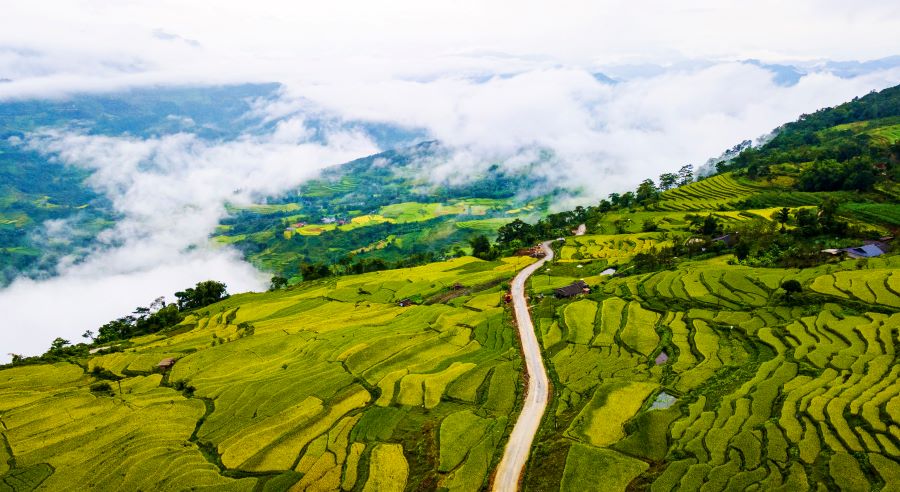
Terraced rice fields in Hong Thai stretch like green ribbons across rolling mountains.
Climate & Seasons
The highland climate is cool and refreshing, providing a comfortable environment for exploration year-round. From September to October, the golden rice season transforms the terraces into undulating waves of yellow along the hillsides, creating one of the most visually stunning periods to visit.
Unique Features
- Terraces are meticulously shaped by generations of Dao, Muong, and Tay communities, reflecting skillful labor and local creativity.
- The combination of dramatic landscapes, small remote villages, and traditional farming practices offers an authentic cultural experience.
- Visitors can enjoy the peaceful, poetic scenery and feel immersed in the tranquility of rural life, far from the bustle of the city.
Travel Tips to Visit Terraced Rice Fields in Northern Vietnam
Best Time to Visit
- For the water-filled terraces, go from May to June when fields reflect the sky like giant mirrors.
- For golden rice season, visit between September and October to see waves of yellow sweeping across the hillsides.
Getting Around
- Consider Vietnam car rental with driver for comfortable and flexible travel between remote villages and terraces.
- Roads can be steep and winding, so a local driver ensures safety and local knowledge.
Trekking & Exploration
- Bring sturdy shoes and light gear; terraces often require walking along narrow paths.
- Follow local guides when trekking for both safety and cultural insight.
- Check out Essential Tips for Vietnam Trekking: stay hydrated, pace yourself, and respect the farming communities.
Cultural Etiquette
- Dress modestly and ask permission before photographing local villagers.
- Participate respectfully in local festivals or farming activities if invited.
Accommodation & Local Food
- Stay in homestays in ethnic villages to immerse yourself in the lifestyle of Dao, Hmong, Thai, or Muong communities.
- Try local dishes made from freshly harvested rice or mountain herbs for an authentic taste of the region.
Photography Tips
- Early morning and late afternoon provide the best light for capturing terraces and misty mountain landscapes.
- Use a wide-angle lens to capture the full curve and scale of the terraces.
Experience the Magic of Northern Vietnam – Book Your Vietnam Tours Today!
Exploring the terraced rice fields of Northern Vietnam is more than a sightseeing trip-it’s a journey into the heart of the mountains, the rhythm of local life, and the breathtaking beauty of nature. From the golden waves of ripe rice to the misty mornings over highland valleys, every moment is a memory waiting to be made. Don’t just imagine it-make it happen! Secure your spot on our Vietnam tours and discover the authentic charm, culture, and adventure that only Northern Vietnam can offer.
FAQs
Start planning your tailor-made Vietnam tour by contacting one of our specialists…





